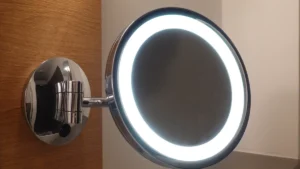
COB strip with PWM dimming is an intelligent method to adjust LED brightness. It rapidly switches the light on and off, creating the appearance of dimmer lighting without wasting energy. This approach is particularly effective with COB LED strips, which provide smooth and uniform illumination. Employing PWM dimming with a COB strip allows for precise brightness control while maintaining consistent colours. Whether for a workspace or a cosy environment, this ensures LEDs perform at their optimum.
Key Takeaways
PWM dimming changes LED brightness by quickly turning it on and off. This gives smooth dimming without lowering light quality.
Picking the right dimmer is important. It must match the LED strip’s power and frequency. This stops flickering and keeps the light steady.
PWM dimming saves energy by using less power and making less heat. This helps your LED strips last longer.
This method keeps colours the same at all brightness levels. It is great for places needing accurate lighting.
To get the best results, use correct wiring. Follow the manufacturer’s instructions when setting up COB LED strips with PWM dimming.
What is PWM Dimming?
Basics of PWM Dimming
How PWM controls brightness through on/off cycles
PWM dimming is a smart way to adjust LED brightness. It turns the LED on and off very quickly. This happens so fast that your eyes see it as steady light. The brightness depends on how long the LED stays on during each cycle. For example, if it’s on for half the time, it looks half as bright. This method lets you change brightness without losing light quality.
The role of frequency in achieving smooth dimming
Frequency is important for smooth dimming. Higher frequency makes the switching too fast for your eyes to notice. Lower frequency can cause flickering, which might be annoying or uncomfortable. To avoid this, pick a dimmer with the right frequency for your LEDs.
Understanding the duty cycle and its impact on brightness levels
The duty cycle decides how bright the LED will be. If the LED is on for 10% of the time, it gives dim light. If it’s on for 90%, the light is much brighter. This lets you adjust the lighting for different needs, like soft room light or bright work light.
Why PWM Dimming is Effective for LEDs
Responsiveness of LEDs to rapid switching
LEDs react quickly to changes in power, making them great for PWM dimming. Unlike old bulbs, they can handle fast on/off cycles without breaking. This quick response allows smooth brightness changes and reliable performance.
Energy efficiency compared to analogue dimming methods
PWM dimming saves more energy than analogue dimming. It controls on/off times instead of lowering power, reducing energy waste and heat. This helps cut energy costs and makes your LED strips last longer. It’s a smart and money-saving choice for modern lighting.
How PWM Dimming Works with COB LED Strips

Compatibility of COB LED Strips with PWM Dimming
Smooth light output improved by PWM
COB LED strips give even and smooth light. PWM dimming makes this even better. It changes brightness by adjusting the pulse width. This lets you dim the light smoothly from very low to very bright. The light stays steady and does not flicker, even when dimmed. To do this, you need a PWM DC dimmer between the power source and the COB strip. This setup helps control dimming and keeps the COB strip working well.
Keeping the same colour with PWM dimming
PWM dimming keeps the light’s colour the same at all brightness levels. Analogue dimming can change the colour, but PWM does not. This is important for places like photo studios or shops where colour matters. With PWM dimming, you can control brightness without losing colour quality. It ensures your LED lighting stays accurate and reliable.
Benefits of Using PWM Dimming for COB LED Strips
Exact brightness control for different uses
PWM dimming lets you control brightness exactly how you need it. You can make soft light for a living room or bright light for work. COB LED strips with PWM dimming can match any setting. This makes them great for homes and businesses. You can always get the right light for the job.
Saving energy and reducing heat
PWM dimming saves energy by switching the light on and off quickly. It uses less power but keeps the brightness. This also makes less heat, keeping the COB strips cool. Less heat means the LEDs last longer and need less fixing. With PWM dimming, you save energy, money, and help the environment.
Advantages and Challenges of PWM Dimming

Advantages of PWM Dimming
Saving energy and cutting costs
PWM dimming helps save energy by controlling power use. It adjusts how long the LEDs stay on, using only needed power. This lowers electricity bills and reduces heat. Less heat means your lights last longer. If you want to save money and keep good lighting, PWM is a great option.
Easy and smooth brightness control
PWM dimming lets you change brightness exactly as you need. You can make the light soft for relaxing or bright for working. It works smoothly without flickering or changing colours. This makes it perfect for homes and businesses.
Works well with smart lighting
PWM dimming works with smart lighting systems. You can connect it to smart dimmers and controllers. This lets you set brightness based on time or activities. It makes lighting easy and fits your needs perfectly.
Advantage | Description |
|---|---|
Energy Saving | PWM dimming lowers power use by adjusting the duty cycle. |
Less Heat | It reduces heat, keeping LEDs cool and working better. |
Longer Light Life | PWM reduces wear, helping LEDs last longer. |
Keeps Colours the Same | PWM keeps colours steady, even when brightness changes. |
Challenges of PWM Dimming
Flickering at low speeds
PWM dimming can flicker if the frequency is too low. This might bother some people or hurt their eyes. To stop this, use a dimmer with high frequency for smooth lighting.
Problems for sensitive people
Some people feel unwell with flickering lights. It can cause headaches or make them uncomfortable. If this happens, buy good dimmers and COB LED strips for steady lighting.
Need for good dimmers
Cheap dimmers can cause problems like flickering or damage to LEDs. Always pick dimmers made for PWM dimming. Good circuits and heat control also help your lights last longer.
Things to watch out for:
Flickering can strain eyes, especially at low frequencies.
Some dimmers or power supplies may not work well together.
Heat control is key to keeping LEDs working longer.
Use dimmers and drivers that match your LEDs.
Design circuits well to keep signals strong.
Use shielded cables to stop interference.
By fixing these issues, you can enjoy PWM dimming and keep your COB LED strips working their best.
Practical Considerations for Using PWM Dimming
Picking the Right Dimmer for COB LED Strips
Making sure it works with COB LED strips
Choosing the correct dimmer is very important. It must match your LED strip’s power and dimming signal. If not, it can cause flickering or harm the LEDs. Always check the maker’s details to ensure they fit. Good-quality drivers are needed for smooth dimming and steady light. Think about where you’ll use it. For places needing perfect light, pick dimmers that keep colours steady.
Picking a dimmer with the right frequency
The dimmer’s frequency stops flickering. Frequencies over 100Hz are usually fine. For smoother light, go for 500Hz or more. High-frequency dimmers make brightness changes smooth and flicker-free. For better control, choose dimmers with 8-bit or 10-bit settings. These give more precise brightness levels.
Fixing Common Problems
Stopping flickering with high-frequency settings
Flickering often happens with low-frequency dimmers. To stop this, use a dimmer with at least 500Hz. High-frequency dimmers keep the light steady and easy on the eyes. Shielding and grounding wires can also stop interference that causes flicker.
Checking if it works with your power supply
Before setting up, test if the dimmer works with your power supply. If they don’t match, dimming might not work well. Use drivers made for COB LED strips for smooth lighting. If you hear buzzing or humming, upgrade to a better dimmer or power supply.
Tips for Installing COB Strips with PWM Dimming
Correct wiring for best results
Good wiring is key for COB LED strips to work well. Use strong cables to avoid power loss, especially for long strips. Make sure all wires are tight and secure. Bad wiring can cause dimming issues or damage your LEDs.
Following the maker’s instructions
Always follow the instructions from the manufacturer. Clean the surface before sticking the strip to make it stay in place. Plan the layout to avoid cutting or overlapping the strip. Check that the dimmer and driver match your LED strip. Following these steps will help your lights last longer and work better.
PWM dimming is a smart way to adjust COB LED strip brightness. It saves energy and keeps the light’s colour steady. By quickly turning the light on and off, it creates smooth dimming. This makes it great for homes and businesses.
Picking the right dimmer is very important. A good PWM DC dimmer stops flickering and works smoothly. Always check the dimmer’s frequency and power match your LED strips.
Here’s a simple comparison of dimming methods to guide your choice:
Dimming Method | Main Benefits | Notes |
|---|---|---|
PWM Dimming | Smooth dimming, wide range, no colour change | Needs a PWM DC dimmer. Best for portable setups. |
TRIAC Dimming | Strong and stylish, good for wall-mounted lights | Requires TRIAC dimmable power supply for COB LED strips. |
0/1-10V Dimming | Works well with many systems, sends stable signals | Needs extra wiring for control lines. |
RF Dimming | Wireless control, works with remotes or smart devices | Needs power calculation and may require more controllers for bigger setups. |
Learning about PWM dimming can improve your lighting setup. Choose the right parts to enjoy better brightness control, save energy, and keep your lights lasting longer.
FAQ
What is the best frequency to stop flickering with PWM?
A frequency over 500Hz works best for smooth dimming. It stops flickering and keeps the light steady. High-frequency dimmers are great for places like homes or offices. Always check the dimmer details before buying.
Can PWM dimming harm COB LED strips?
No, PWM dimming is safe for COB LED strips if you use the right dimmers. It even helps them last longer by lowering heat. Use good-quality dimmers and follow the maker’s instructions for the best results.
Why does my LED strip flicker when dimming?
Flickering happens with low-frequency dimmers or wrong power supplies. Fix this by using a dimmer with over 500Hz frequency. Also, make sure your power supply matches the LED strip’s needs for smooth lighting.
Does PWM dimming change the colour of COB LED strips?
No, PWM dimming keeps the colour the same at all brightness levels. Unlike other dimming methods, it doesn’t change the light’s colour. This makes it ideal for places needing accurate colours, like shops or studios.
How can I make sure my PWM dimmer works with smart systems?
Pick a dimmer made for smart systems. Look for features like remote control or app settings. Many modern PWM dimmers work well with smart home setups, giving you easy control over your lights.
💡 Tip: Test your dimmer with your setup first to check compatibility and avoid problems.
See Also
Innovative Developments In Dimmable COB LED Strip Lighting
Current Trends In Dimmable COB LED Strip Illumination
Choosing The Ideal RGB+W COB LED Strip For You



